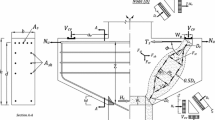Abstract
This paper presents an application of strut-and-tie model (STM) to design the interior anchorage zone (IAZ) in the post-tensioned concrete structure. The STM theory and range of IAZ are introduced. Then, based on the finite element analysis, a series of simplified equations to calculate internal forces in IAZ are presented. Finally, the STM model for IAZ is given. In the proposed STM model, internal forces in ties vary with the dimension ratio and the eccentricity of load. The U-turn of internal forces is suggested to allocate rebar to resist bearing flexural tensile force. Compared with the FIP (International Federation for Prestressing) model, the proposed STM model is more reasonable and applicable.
Similar content being viewed by others
Abbreviations
- b :
-
Lateral dimension of anchor
- e :
-
Eccentricity of post-tensioned load
- F b :
-
Bursting force
- F c :
-
Internal force in strut
- F FT :
-
Flexural tensile force
- F t :
-
Tie force
- F TB :
-
Tie-back force
- h :
-
Lateral dimension of member
- h 1 :
-
Lateral dimension of Guyon’s symmetrical prism
- l :
-
Distance from right boundary of anchor to right boundary of member
- P :
-
Post-tensioned load
- σ 0 :
-
Average stress on the cross section of member
- σ1, σ2:
-
Longitudinal stress on left and right side of member
- σ b :
-
Bursting stress
- σ FT :
-
Flexural tensile stress
- σ t :
-
Tie stress
- σ TB :
-
Tie-back stress
References
FIP. FIP recommendations 1996, practical design of structure concrete [Z]. London: Telford, 1998.
AASHTO. LRFD bridge design specifications [M]. Washington: AASHTO, 2004.
Eurocode 2 Part 1, 1-prEN 1992-1-1-2002, Design of concrete structures-Part 1. General rules and rules for buildings [S].
Podolny W J. The cause of cracking in post-tensioned concrete box girder bridges and retrofit procedures [J]. Journal of the Prestressed Concrete Institute, 1985, 30(2): 82–139.
Rogowsky D M, Marti P. Detailing for posttensioned [M]. Bern: VSL International LTD, 1996.
Leonhardt F. Prestressed concrete design and construction [M]. Berlin: Wilhelm Emst and Sohn, 1964.
Schlaich J, Schafer K. Design and detailing using strut-and-tie models [J]. The Structural Engineer, 1991, 69(6): 113–125.
Schlaich J, Schafer K, Jennewein M. Toward a consistent design of reinforced and prestressed concrete structures [J]. PCI Journal, 1987, 32(3): 74–151.
Mörsch E. Uber die berechnung der gelenkquader [J]. Beton-und-Eisen, 1924, 12: 156–161.
Burdet O L. Analysis and design of anchorage zones in post-tensioned concrete bridges [D]. Austin: University of Texas at Austin, 1990.
Sanders D H, Breen J E. Post-tensioned anchorage zones with single straight concentric anchorages [J]. ACI Structural Journal, 1997, 94(2): 146–158.
Guyon Y. Limit-state design of prestressed concrete [M]. New York: John Willey and Sons, 1974. 279–284
Author information
Authors and Affiliations
Corresponding author
Additional information
Foundation item: the National High Technology Research and Development Program (863) of China (No. 2006AA09A103) and the Shanghai Leading Academic Discipline Project (No. B208)
Rights and permissions
About this article
Cite this article
Zhao, Jl., Shen, Sl. & Sun, Y. Application of strut-and-tie model for design of interior anchorage zone in post-tensioned concrete structure. J. Shanghai Jiaotong Univ. (Sci.) 15, 273–278 (2010). https://doi.org/10.1007/s12204-010-1002-6
Received:
Published:
Issue Date:
DOI: https://doi.org/10.1007/s12204-010-1002-6
Key words
- post-tensioned concrete structure
- interior anchorage zone (IAZ)
- strut-and-tie model (STM)
- internal forces
- simplified equations




